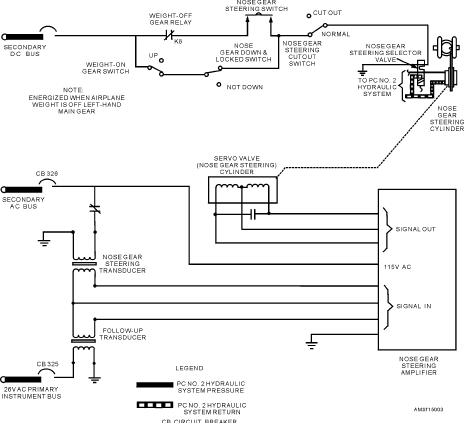
geared to the vane motor shaft. See figure 15-2. During
components to provide the nosewheel steering
the steering mode of operation, vane motor rotation
function. When not in the steering mode of operation,
drives the feedback potentiometer. When driven, the
the nosewheel steering power unit serves as a
position transmitter provides a feedback signal to the
nosewheel shimmy damper.
steering amplifier that is proportional to the amount of
The nosewheel steering power unit is mounted to
vane motor rotation.
the nose landing gear cylinder, and the output drive gear
is meshed with the ring gear of the nose landing gear
COMMAND POTENTIOMETER.--The com-
torque collar. The torque collar deflects the nosewheel
mand potentiometer is attached to the rudder pedal
as selected by rudder pedal positioning. Hydraulic fluid
linkage. When the rudder pedals are moved, the
displaced by the rotating vane during the steering mode
command potentiometer generates an electrical signal
is directed back to the hydraulic return system.
proportional to the amount of rudder pedal deflection.
When in the damping mode, fluid displaced by a
STEERING AMPLIFIER.--The steering am-
rotating vane is directed through an orifice restrictor
plifier sums the signals received from the feedback
inside the nosewheel steering power unit to the opposite
potentiometer and the command potentiometer. This
side of the vane to provide the dampening feature.
summation is converted to a modulating signal that is
NOSEWHEEL S T E E R I N G S O L E N O I D
directed to the nosewheel steering power unit's servo
SELECTOR VALVE.--The nosewheel steering
valve for nosewheel steering response. With the signals
solenoid selector valve is an electrically controlled and
from the command and feedback potentiometer
hydraulically operated valve. The valve provides
balanced, the servo is returned to a neutral condition,
pressure and return fluid porting during the steering
and the nosewheel steering power unit stops at the
mode of operation.
selected position.
Electrical Components
ELECTRICALLY CONTROLLED NOSE
STEERING SYSTEM MAINTENANCE
Nosewheel steering electrical components vary
greatly. The system uses three basic components. These
Maintenance of an electrically controlled nose gear
components are the feedback potentiometer, the
steering system consists of operational checks,
command potentiometer, and the steering amplifier.
troubleshooting, system bleeding, and parts adjust-
ment. These maintenance functions normally require a
FEEDBACK POTENTIOMETER.--The feed-
joint effort on the part of the AM and the AE personnel.
back potentiometer is mounted to the nosewheel
See figure 15-3.
steering power unit, and is mechanically linked or
Figure 15-3.--Nose gear steering system diagram.
15-3

